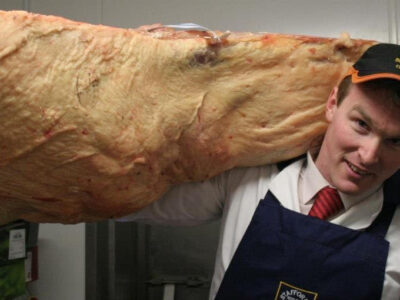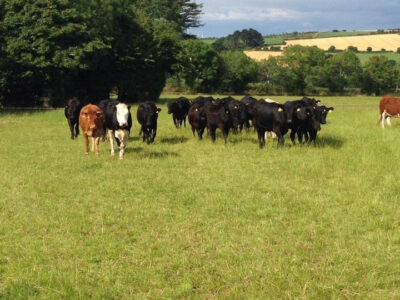€0.00
While most supermarket hams are soaked in a liquid brine and then smoked, dry cured hams are packed with salt and stored until they are cured. In America, many ham recipes include sweet glazes that include things like brown sugar or marmalade, but many Irish ham recipes suggest foregoing the sweet ham glazes for savory ones
Dry Cured Ham is cured without the use of water (as the name implies). The meat is preserved by burying it in salt or rubbing it with salt and other spices. Then the ham is hung up to dry for a long period of time, months in fact.
The preserving of pork leg as ham has a long history. Many credit the Chinese as being the first people to record curing raw hams, while other have cited the Gauls. It cannot be argued though that it was certainly a well-established practice by the Roman period.
The word ham might make you immediately think of the spiral-sliced roast you eat around the holidays or the thin-sliced meat you buy from the supermarket deli counter. However, it refers to a specific part of the pig: The rear leg. Although that ham is most commonly cured or processed somehow, this cut also makes a beautiful pork roast if you can find someone to sell you a fresh ham. Ham has a perfect balance between fat and lean meat and since it’s a bone-in cut with muscles that get a lot of movement, it’s pretty flavourful.
1. Traditional Artisanal Process: Irish dry cured ham is made using a traditional, time-honored method that involves dry curing the ham with a mixture of salt, sugar, and sometimes other seasonings. This process helps to enhance the natural flavor and preserve the meat.
2. Quality Ingredients: Irish dry cured hams are typically made with high-quality pork sourced from Irish farms known for their high animal welfare standards. The focus is on using quality ingredients to produce a superior product.
3. Slow Curing: The dry curing process for Irish ham is slow and involves covering the ham with a salt and sugar mixture, which draws out moisture from the meat. This helps to intensify the flavour and preserve the ham.
4. No Water Added: Unlike some other types of ham, Irish dry cured hams do not have water or brine injected into them. This ensures that the flavor is concentrated and not diluted during the curing process.
5. Flavors and Seasonings: While plain salt is the primary ingredient in the curing process, some Irish dry cured hams may incorporate additional flavors and seasonings such as herbs, spices, or even whiskey, giving the ham a unique taste profile.
6. Versatile Use: Irish dry cured ham is a versatile ingredient that can be enjoyed in various ways. It can be sliced and served as a cold cut, used as a filling in sandwiches or wraps, added to salads or pasta dishes, or even enjoyed in omelets or quiches.
7. Slicing Style: Traditionally, Irish dry cured ham is thinly sliced. This slicing style allows for a more delicate texture and better appreciation of the layers of flavors.
8. Popular Dish: A popular and traditional Irish dish featuring dry cured ham is Colcannon, which is made with mashed potatoes, cabbage or kale, and diced ham. It is often served as a comforting main course.
9. Storing: Irish dry cured ham should be stored in a cool, dry place. It is best to consume it within a few days of opening the packaging to enjoy its freshness and flavor.
10. Exported Worldwide: Irish dry cured ham has gained popularity internationally and is exported to various countries. Its high-quality taste and traditional production methods have made it a sought-after product.



















Stafford’s Butchers is family run and owned. We hand-rear our own Angus cattle on our farm in Killanne. Killanne for those people who don’t know, is a slice of heaven situated in the foothills of the Blackstairs Mountains in the County of Wexford.
It is a place where community is important and neighbours are good friends, it has stunning scenery and top quality grass. We may be biased but we have been told that you can taste the difference in our tender beef and steak. Our beef is literally delivered from our gate to your plate.
Stafford’s butchers was founded by Brendan Stafford in 1971. In 1961, aged 16 Brendan started in the butcher business – ‘I started my trade in Moore Street before moving home to Wexford’. Brendan set up his business in Enniscorthy and has always promoted traditional breeds of cattle like Hereford & Angus.
“For good quality beef you need the traditional breeds of cows, the bit of fat on these cattle gives the meat the perfect flavour. We find meat is lacking in flavour in the big continental animals, so we go for the young traditional cattle which have a lot of flavour.”
Brendan’s son Killian is now in control of the business, while Brendan looks after the farming and producing quality beef which we supply to all our customers.
“We pride ourselves on top quality produce, we have always maintained keeping the best quality of meat because if you cut the quality of your meat you’re just the same as everyone else, you need to stand out from the crowd.”
We have always promoted traditional breeds of cattle like Aberdeen Angus. “For good quality beef you need the traditional breeds of cows, the bit of fat on these cattle gives the meat the perfect flavour.” Angus beef develops with better marbling than most cattle. Marbling is the amount of intramuscular fat. Most people agree that marbling improves flavour, tenderness, and keeps meat moist while cooking (especially at high temperatures).
Heifer beef is more tender and it’s a sweeter beef so this is why we only breed heifers. We definitely believe in quality over quantity, we could breed a bigger amount of cattle but we only keep the best.
In most supermarkets they wet age their beef so it don't lose moisture and weight, which means more profit. We use traditional method of dry ageing our beef for 40 days, this gives the beef better flavour and much more tender.
We are a proper Butcher’s, in that we have all the traditional cuts of meat. We have T-Bones, Rib Roast on the Bone, our own Dry Aged Steak, Striploin and we also have some of the more traditional cuts that are making culinary comebacks like Oxtail, Beef Kidneys,
We take great pride in our skill, ask us for advice on how to cook these traditional cuts. In a real butcher’s, meat has meaning.
We stock the best quality Wexford Lamb, we have all the traditional cuts of lamb available in the shop, Racks of Lamb, Shoulder of Lamb, Legs of Lamb. We also have very tasty homemade Lamb burgers and Lamb Meatballs as well.
Thanks to the mild Wexford weather, lamb spends most of the year outside and therefore is primarily fed off grass, making it almost organic.
Lamb is high in essential minerals, proteins and vitamins necessary for good health. It is extremely rich in Vitamin B12 and Vitamin D, very rich in Zinc, high in CLA’s and rich in desirable Omega-3 fatty acids. All in all, lamb is a perfect meal choice for all the family.
Lamb is very versatile – whether you’re preparing a quick midweek meal or a dinner for family or friends, the sweet distinctive flavour of lamb is sure to put a smile on everyone’s face.
Our award–winning pork, bacon and sausage products are all made using superb quality 100% Irish pork. The pork is from pigs selected from our trusted local farmers.
At Stafford’s we home cure our own rashers, they look and taste how rashers should, how they used to taste! Our Home Cured rashers are lower in Salt so are healthier too! We don’t add any extra water, they are home cured in the traditional way by us, using only the best 100% Irish bacon. You really have to taste them!
Another speciality at Stafford’s is our Gold Medal Award Winning sausages. These are made daily on the premises in a range of flavours.
Killian devised a banger with a unique black pepper and red onion flavour that wowed the critics from the Associated Craft Butchers of Ireland.
All our Chicken is locally sourced and we support Bord Bia Quality Assured Farms, where animal welfare is of paramount importance. Our Chickens come form a local supplier Ray Keogh Foods, and we have great value whole birds as well as Free Range birds. Our chicken breasts are full of chicken, not pumped full of saline solution, which means they stay firm and fleshy when cooked, yet remain satisfyingly moist, too. We make our own Chicken Stir-fry from our fresh vegetables delivered daily, and the best quality Chicken breasts.